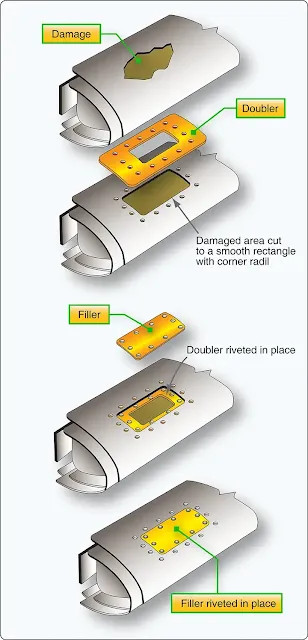In aircraft construction, stressed skin is a form of construction in which the external covering (skin) of an aircraft carries part or all of the main loads. Stressed skin is made from high strength rolled aluminum sheets. Stressed skin carries a large portion of the load imposed upon an aircraft structure. Various specific skin areas are classified as highly critical, semicritical, or noncritical. To determine specific repair requirements for these areas, refer to the applicable aircraft maintenance manual.
Minor damage to the outside skin of the aircraft can be repaired by applying a patch to the inside of the damaged sheet. A filler plug must be installed in the hole made by the removal of the damaged skin area. It plugs the hole and forms a smooth outside surface necessary for aerodynamic smoothness of the aircraft. The size and shape of the patch is determined in general by the number of rivets required in the repair. If not otherwise specified, calculate the required number of rivets by using the rivet formula. Make the patch plate of the same material as the original skin and of the same thickness or of the next greater thickness.
Patches
Skin patches may be classified as two types:
- Lap or scab patch
- Flush patch
Lap or Scab Patch
The lap or scab type of patch is an external patch where the edges of the patch and the skin overlap each other. The overlapping portion of the patch is riveted to the skin. Lap patches may be used in most areas where aerodynamic smoothness is not important. Figure 1 shows a typical patch for a crack and or for a hole.
 |
| Figure 1. Lap or scab patch (crack) |
When repairing cracks or small holes with a lap or scab patch, the damage must be cleaned and smoothed. In repairing cracks, a small hole must be drilled in each end and sharp bend of the crack before applying the patch. These holes relieve the stress at these points and prevent the crack from spreading. The patch must be large enough to install the required number of rivets. It may be cut circular, square, or rectangular. If it is cut square or rectangular, the corners are rounded to a radius no smaller than 1⁄4-inch. The edges must be chamfered to an angle of 45° for 1⁄2 the thickness of the material, and bent down 5° over the edge distance to seal the edges. This reduces the chance that the repair is affected by the airflow over it. These dimensions are shown in Figure 2.
 |
| Figure 2. Lap patch edge preparation |
Flush Patch
A flush patch is a filler patch that is flush to the skin when applied it is supported by and riveted to a reinforcement plate which is, in turn, riveted to the inside of the skin. Figure 3 shows a typical flush patch repair. The doubler is inserted through the opening and rotated until it slides in place under the skin. The filler must be of the same gauge and material as the original skin. The doubler should be of material one gauge heavier than the skin.
 |
| Figure 3. Typical flush patch repair |
Open and Closed Skin Area Repair
The factors that determine the methods to be used in skin repair are accessibility to the damaged area and the instructions found in the aircraft maintenance manual. The skin on most areas of an aircraft is inaccessible for making the repair from the inside and is known as closed skin. Skin that is accessible from both sides is called open skin.
Usually, repairs to open skin can be made in the conventional manner using standard rivets, but in repairing closed skin, some type of special fastener must be used. The exact type to be used depends on the type of repair being made and the recommendations of the aircraft manufacturer.
Design of a Patch for a Non-pressurized Area
Damage to the aircraft skin in a non-pressurized area can be repaired by a flush patch if a smooth skin surface is required or by an external patch in noncritical areas. [Figure 4] The first step is to remove the damage. Cut the damage to a round, oval, or rectangular shape. Round all corners of a rectangular patch to a minimum radius of 0.5-inch. The minimum edge distance used is 2 times the diameter and the rivet spacing is typically between 4-6 times the diameter. The size of the doubler depends on the edge distance and rivet spacing. The doubler material is of the same material as the damaged skin, but of one thickness greater than the damaged skin. The size of the doubler depends on the edge distance and rivet spacing. The insert is made of the same material and thickness as the damaged skin. The size and type of rivets should be the same as rivets used for similar joints on the aircraft. The SRM indicates what size and type of rivets to use.
 |
| Figure 4. Repair patch for a non-pressurized area |
RELATED POSTS



